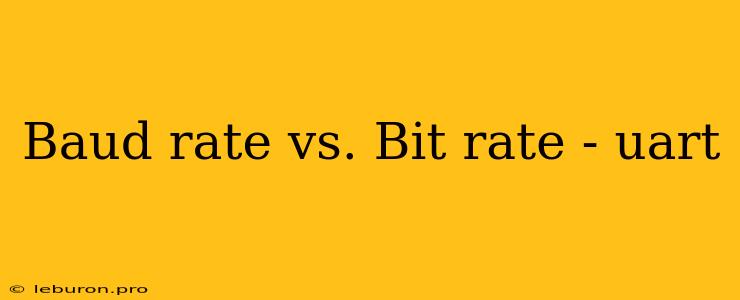In the realm of digital communication, transmitting data efficiently and accurately is paramount. To achieve this, we rely on protocols that define the rules of data transfer. One such protocol, universally used in microcontrollers and other embedded systems, is the Universal Asynchronous Receiver/Transmitter (UART). UART relies on a fundamental concept: baud rate and bit rate, both of which are critical parameters in determining the data transfer speed and efficiency. While these terms are often used interchangeably, they hold distinct meanings and understanding their differences is vital for successful communication. This article aims to delve into the nuances of baud rate and bit rate in the context of UART communication, unraveling the relationship between them and their impact on data transmission.
Baud Rate: The Measure of Symbol Transitions
Baud rate refers to the number of symbol changes or transitions that occur per second during data transmission. It is typically measured in baud or symbols per second (sps). A symbol represents a distinct signal state that can be used to convey information. In the case of UART, a symbol might correspond to a voltage level shift, a pulse edge, or any other change in the signal.
For instance, a UART communication operating at a baud rate of 9600 baud means that the signal line experiences 9600 changes in its state every second. Each change can signify a different data bit, allowing for data transmission at a specified rate.
Impact of Baud Rate on Data Transmission
The baud rate directly influences the maximum achievable data transfer rate. A higher baud rate means more symbol transitions per second, allowing for a faster data transfer. However, it's crucial to note that baud rate doesn't equate to the actual data bit rate.
Bit Rate: The True Measure of Data Transfer Rate
Bit rate, often referred to as the data rate, represents the number of data bits transmitted per second. It is typically measured in bits per second (bps). Unlike baud rate, which considers all signal changes, bit rate focuses solely on the data bits being sent.
To understand the relationship between baud rate and bit rate, consider the following:
- Basic UART: In a basic UART communication, each symbol represents one data bit. In this scenario, the baud rate and bit rate are equivalent. For example, a UART operating at a baud rate of 9600 baud will also have a bit rate of 9600 bps.
- Advanced UART: Advanced UART configurations might utilize multiple symbols to represent a single data bit. For example, in a UART using a specific encoding scheme, two symbols could be used to represent a single data bit. In such cases, the bit rate will be lower than the baud rate. A baud rate of 19200 baud could result in a bit rate of 9600 bps if two symbols are used to represent each data bit.
Factors Affecting Baud Rate and Bit Rate Selection
The selection of baud rate and bit rate depends on various factors, including:
- Data Requirements: The type and volume of data to be transmitted influence the required bit rate. Higher data volumes demand faster bit rates.
- Communication Medium: The physical characteristics of the communication medium, such as noise levels and cable length, affect the maximum achievable baud rate. A noisy environment or long cable distances might require lower baud rates for reliable data transmission.
- Hardware Limitations: The capabilities of the transmitting and receiving devices, such as the UART controller's maximum supported baud rate, also impose constraints.
- Compatibility: Ensuring compatibility between the transmitting and receiving devices is crucial. Both devices must operate at the same baud rate to establish a successful communication link.
Consequences of Mismatched Baud Rates
Mismatched baud rates between the transmitting and receiving devices can lead to various communication issues, including:
- Data Corruption: Data bits might not be interpreted correctly by the receiver due to misalignment in the timing of signal transitions.
- Incomplete Data Transmission: The receiver might miss data bits if it is unable to keep up with the faster transmission rate.
- Communication Failure: In extreme cases, mismatched baud rates can completely disrupt communication, resulting in no data transfer.
Conclusion
Baud rate and bit rate are essential parameters in UART communication, playing a crucial role in determining the speed and accuracy of data transfer. Understanding their distinct meanings and the relationship between them is crucial for successful communication. By selecting appropriate baud rates and bit rates, taking into account factors like data requirements, hardware limitations, and compatibility, we can ensure reliable and efficient data transmission using UART.
Remember that while baud rate reflects the number of signal transitions, bit rate represents the true measure of data bits transmitted per second. By carefully considering these parameters, we can unlock the full potential of UART for communication in embedded systems and microcontrollers.
